OS grid reference SJ 616,885 Country England Spire height 86 m Phone +44 1925 635020 | Denomination Anglican Status Parish church Parish Warrington | |
 | ||
Similar Holy Trinity Church - Warrington, St Oswald's Church - Winwick, St James' and St Paul's Ch, St John the Evangelist's Church, Baptist Chapel - Great Wa | ||
St Elphin's Church is the parish church of the town of Warrington, Cheshire, England. The church is recorded in the National Heritage List for England as a designated Grade II* listed building. It is an active Anglican parish church in the diocese of Liverpool, the archdeaconry of Warrington and the deanery of Warrington.
Contents
History
A place of worship has been present on the site since about 650, and the presence of a priest in Warrington was recorded in the Domesday Book. According to tradition the first church was built by Saint Oswald for his companion Elphin, who remained as the first priest there until his death in 679. The earliest fabric in the present church is in the chancel and the crypt, which survive from the church built in 1354 by Sir William Boteler. The church was badly damaged by the Parliamentary forces in the Civil War. Following this the tower was rebuilt in 1696 and the nave in 1770. The south aisle was added in the early 19th century. Most of the fabric of the present church is the result of an extensive restoration between 1859 and 1867 by Frederick and Horace Francis. It was during this restoration that the spire was added. The bells were recast in 1698 and again in 1884. In 1950 they were recast again and the clock was replaced.
Within the church, St Ann's Chapel was founded by Thomas Massey, rector of Warrington from 1448 to 1464. It continued to belong to the Massey family until they died out in 1748. The chapel was then acquired by the Patten family who built a vault to bury members of the family, the last being Lord Winmarleigh in 1892. The Lady Chapel was founded and endowed by Sir John Boteler in 1290. He and other family members were buried in the chapel. In 1943 it became the chapel of the South Lancashire Regiment and in 1976 the chapel of The Queen's Lancashire Regiment.
Exterior
The plan of the church consists of a wide nave, wide north and south aisles with a chapel at the eastern end of each aisle, a central tower with a tall spire at the crossing, and a chancel.
Interior
In the aisles are galleries containing pews with doors. The reredos dates from 1933 which was further decorated in 1999 by Ronald Sims. The organ screen dated 1908 by William and Segar Owen is very elaborate. The pipe organ was built in 1876 by Gray & Davison at a cost of £1,296. Additions were made by the same firm in 1881. It was rebuilt in 1902 by Young and again in 1946 by Rushworth & Draper Ltd of Liverpool, at a cost of about £6,000 but is now unused. It has now been replaced with a digital Organ by Phoenix Organs of some 61 speaking stops in 2005. Some of the stained glass in the church is by Pugin. This was damaged in the second world war and has been re-set. Other glass is by A. Gibbs. The monuments include tablets to Dr Thomas Percival, who died in 1804, by H. Rouw (brother of Peter Rouw), and to Thomas Lyon, who died in 1818, by Webster of Kendal.
The regimental chapel includes a number of ancient monuments. These include an effigy to Lady Alicia Boteler from the early 14th century and an alabaster monument to Sir John Boteler who died in 1463 and his wife. The screen is a Boer War memorial dated 1903 by William and Segar Owen. The stained glass in the chapel is a Second World War memorial by Hugh Ray Easton dated 1947. In St Ann's Chapel are monuments to the Massey and Patten families.
Spire
The church is dominated by its spire, 281 feet (86 m) high. It is
